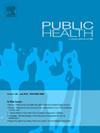注射不是疫苗;这是一个“镜头”。
IF 3.9
3区 医学
Q1 PUBLIC, ENVIRONMENTAL & OCCUPATIONAL HEALTH
引用次数: 0
摘要
之前的工作在社交媒体上发现了一种新型的疫苗怀疑主义,其核心是质疑COVID-19疫苗作为疫苗的地位,部分原因是将“疫苗”与“注射”进行了对比。这项研究旨在调查这种怀疑是否也体现在“疫苗”和“刺戳”之间的对比中,“刺戳”一词在英国部分地区更常用。研究设计基于语料库的语篇分析。方法使用261203条关于MMR疫苗的推文语料库,我们使用搭配和一致性来识别与COVID-19同时出现的“jab”及其变体的实例。我们定性地检查了50%的相关推文(n = 319),以确定任何破坏COVID-19疫苗作为疫苗地位的推文。结果18% (n = 59)的推文使用“刺戳”来破坏COVID-19疫苗作为疫苗的地位。“注射”被认为不如“疫苗”,因为它不能预防感染。尽管这种对比主要集中在COVID-19疫苗上,但一些推文也将流感疫苗作为另一个例子,因此它不是疫苗。我们的分析表明,“jab”及其变体被认为是一种次于疫苗接种的干预措施,类似于之前工作中的“shot”。这一证据表明,在旨在鼓励在英国接种疫苗的公共卫生运动中,最好避免“刺戳”及其变体。本文章由计算机程序翻译,如有差异,请以英文原文为准。
A jab is not a vaccine; it's a ‘shot’
Objectives
Previous work identified a new type of vaccine scepticism on social media centred around questioning the status of the COVID-19 vaccine as a vaccine, partly by contrasting ‘vaccine’ with ‘shot’. This study aimed to investigate whether this scepticism also manifests with a contrast between ‘vaccine’ and ‘jab’, a term more commonly used in parts of the United Kingdom.
Study design
Corpus-based discourse analysis.
Methods
Using a corpus of 261,203 tweets focused on the MMR vaccine, we used collocations and concordancing to identify instances of ‘jab’ and its variants that co-occurred with references to COVID-19. We qualitatively examined 50 % of the relevant tweets (n = 319) to identify any that undermined the status of the COVID-19 vaccines as vaccines.
Results
18 % (n = 59) of the examined tweets used ‘jab’ to undermine the status of the COVID-19 vaccine as a vaccine. A ‘jab’ was seen as inferior to a ‘vaccine’ on the basis that it did not prevent infection. Although this contrast mostly focused on the COVID-19 vaccine, some tweets also referenced the flu vaccine as another example that is therefore not a vaccine.
Conclusions
Our analysis showed that ‘jab’ and its variants are seen to indicate an intervention that is inferior to vaccination, similarly to ‘shot’ in previous work. This evidence suggests that ‘jab’ and its variants are best avoided in public health campaigns designed to encourage uptake of vaccinations in the UK.
求助全文
通过发布文献求助,成功后即可免费获取论文全文。
去求助
来源期刊

Public Health
医学-公共卫生、环境卫生与职业卫生
CiteScore
7.60
自引率
0.00%
发文量
280
审稿时长
37 days
期刊介绍:
Public Health is an international, multidisciplinary peer-reviewed journal. It publishes original papers, reviews and short reports on all aspects of the science, philosophy, and practice of public health.
 求助内容:
求助内容: 应助结果提醒方式:
应助结果提醒方式:


